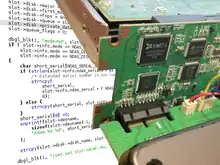Network Direct Attached Storage
Network Direct Attached Storage (NDAS) is a proprietary storage area network system, originally marketed by the company Ximeta, for connecting external digital storage devices such as hard-disks, flash memory and tape drives via the Ethernet family of computer networks. Unlike other more common forms of networked storage, NDAS does not use TCP/IP to communicate over the network. Instead a Lean Packet Exchange (LPX) protocol is used.[1] NDAS also supports some limited RAID functions such as aggregation and mirroring.
History
In 2001, Han-gyoo Kim of Korea and Zhe Khi Pak of Russia applied for a US patent on a "network-attached disk".[2] By 2002 the first NetDisk (up to 80 GB) was marketed as a low cost alternative to full computer based network storage options. The Ximeta company was founded in 2003.[3] In 2004 Kim applied for a patent to allow multiple clients write access to the shared block storage device.[4] By 2006, sizes up to 500 GB were supported.[5] In 2008 an NDAS device called "ShareDisk Gigabit" created by Co-World Cs in Germany briefly claimed the title of world's fastest network storage device.[6] In 2011 IOCELL Networks announced ownership of the NDAS system and NetDisk patents.[7]
Benefits
- Hardware is typically easy to set up and use, particularly when a unit is purchased with a disk installed.
- The disk drive can be used via multiple interfaces (typically eSATA, USB or Ethernet) though not concurrently: USB and eSATA allow access by only one host.
- The disks do not require special formatting so they can be treated as external disks on a wide variety of computers.
- Performance (speed vs. cost) is claimed to be better than similarly priced storage devices.
- Devices are isolated from external network discovery since the protocol is not visible through a router.
Drawbacks

- The LPX Protocol is not routable, thus limiting access to one local area network.
- Some firewall programs block the LPX protocol by default. It uses EtherType value 0x88AD.
- Drivers required to operate NDAS devices over a network are not shipped with operating systems. The devices are usually accompanied with client driver software for Microsoft Windows operating systems.
- Drivers for Linux-based operating systems (Linux distributions such as Fedora, Ubuntu or Debian) are available only from the manufacturer. The Linux connection package does have a shared read and write access mode. However it must be used with a multi-client file system.[8]
An open source management interface was made available for Linux in 2009.[9]
A similar protocol is ATA over Ethernet.
References
- Bruce Normann (November 28, 2011). "IOCELL NetDISK 351UNE Network Storage Device". Benchmark Reviews. Product review. Retrieved June 1, 2013.
- Disk system adapted to be directly attached to network. U.S. Patent 7,792,923 by Han-gyoo Kim and Zhe Khi Pak, Filed October 9, 2001, granted September 7, 2010.
- "Ximeta: Creator of NDAS". Archived from the original on April 20, 2019. Retrieved June 1, 2013.
- System using a single host to receive and redirect all file access commands for shared data storage device from other hosts on a network . U.S. Patent 7,457,880 by Han-gyoo Kim, Filed September 27, 2004, granted November 25, 2008.
- "Ximeta NetDisk Portable". Review. CNet. November 2, 2006. Retrieved June 1, 2013.
- "The World's Fastest Network Storage" (PDF). Ximeta, Germany. May 2008. Retrieved June 1, 2013.
- "IOCELL Networks Purchases Innovative NDAS Technology". News release. IOCELL. August 4, 2011. Retrieved June 1, 2013.
- "Network Direct Attached Storage For Linux". Vendor web site. Retrieved June 1, 2013.
- "kandas: Management infrastructure for NDAS devices". Google code web site. Retrieved June 1, 2013.